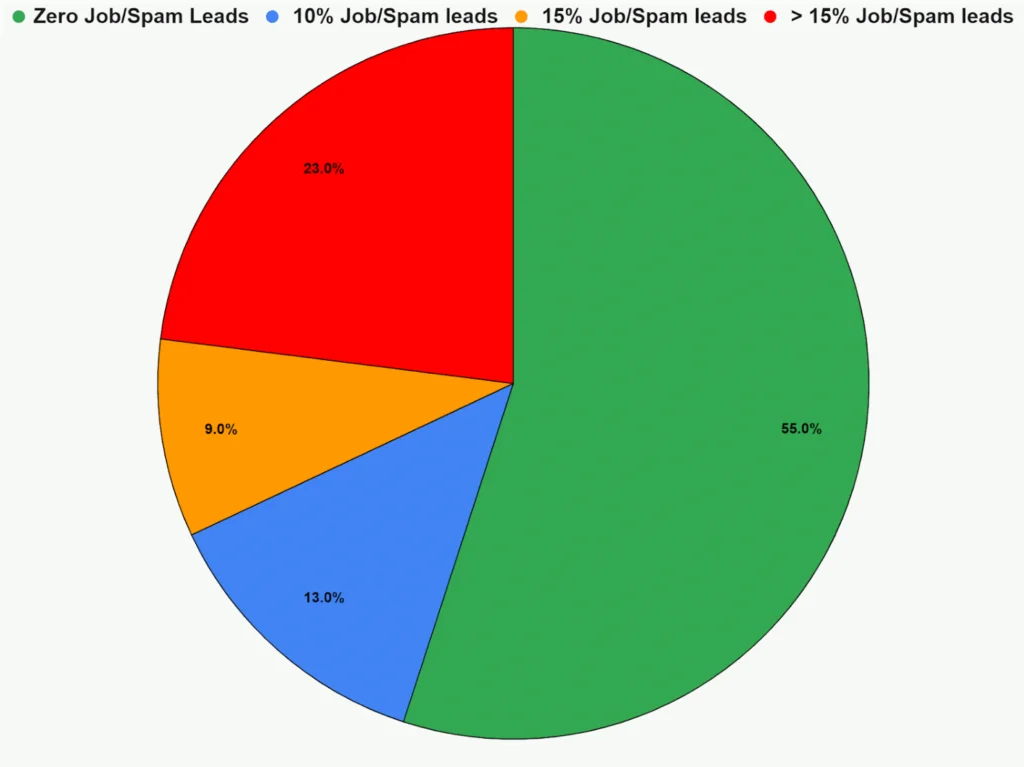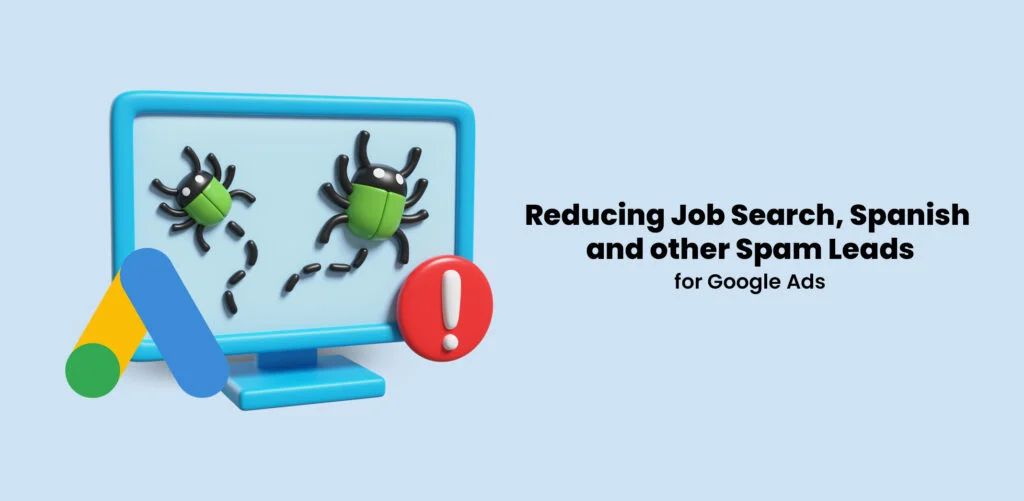Spam form fills on your landing page, and spam calls are nuisances. However, when paying for leads/clients through Ads, Spam costs you money. This article will help you reduce spam.
Sometimes, it seems that spam leads are a part of life and that nothing can be done about them. However, quite a few things can be done to reduce or, at times, completely eliminate spam leads.
We will detail four techniques we have used with hundreds of client Google ads campaigns to reduce spam leads. We will cover the following:
- What are the types of Spam leads?
- Stopping the known spammers
- Reducing spam through better targeting
- Reducing Spam by choosing where your Ad is served
- Preventing Spanish Form Fills
- Practically speaking, what level of Spam is acceptable?
What are the different types of Spam leads?
- Just Junk: This is where you get a form submission with gibberish. You know with one look that this is spam. Usually, it is from a bad actor intentionally spamming you.
- Spanish or another language: When you want to submit only English forms, you get Spanish or other language forms.
- Job Seekers: Not technically spam, but a job seeker filling out your client form could be more desirable.
- Service Mismatch: When a call or form fill is about a service you don’t provide, this is technically not spam but needs to be reduced.
- Wrong Number: If you are not filtering out competition or intentionally targeting competition, calls that were meant for your competition will come in.
- Selling service: Instead of being your client they want you to become their clients.
Stopping the known spammers
There are two solutions to avoid known spammers:
- Use spam prevention software like Click cease
- Build your database of spammy IPs by looking at your form fills. And ban these IPs through Google ads. This technique only works if you run many ads to create an extensive enough database. If you want to leverage our list of malicious IPs, you can get it from here
Reducing the spam through better targeting
A) Google ads allow the exclusion of certain Audience segments. We recommend and exclude: Employment-related Category

B) Some Geo/Locations might produce more spam; if this is the case remove this area from your targeting.
C) Keywords: Some keywords bring a lot more Job seekers and spammers, these should be negated.
D) Age Group-based filtering: In certain cases, spam is higher for a specific age group, this can be filtered out if that age group is not the most important segment for the service.
Reducing the spam through a better copy
Ad copy should be about services; avoid general company info and terms like jobs and careers.
On forms, DO NOT use language like “We are not hiring,” No
Trabajar,” or “Don’t Apply for Jobs”. This language distracts your legitimate leads and does not discourage job seekers from applying. If anything, by highlighting Job Seekers, you are getting their attention, and if your landing page is search-enabled, it will show up on their job search searches.
Reducing Spam by choosing where your Ad is served
Google serves search ads on two primary platforms: search page and search partner networks. Typically, Google search partner network leads are cheaper (with lower CPC) but more spammy.

We use and recommend the following heuristics when using Google search partners.
When starting a brand new ad campaign:
A) Keep the search network on till you get 15 -20 Leads
B) If job/Spam leads are greater than 15% of total leads
AND 50% or more of this spam is coming from search partner networks; stop Partner network
A) Keep the search network on till you get 15 -20 Leads
B) If job/Spam leads are greater than 15% of total leads
AND 50% or more of this spam is coming from search partner networks; stop Partner network
Preventing Spanish Form Fills
We use Form-validation Java scripts to check for non-English submissions. This prevents all Spanish and some pure gibberish submissions. The critical thing to note here is that this will avoid forms of spam, but with Google ads, you have always paid for the click! There is another hidden benefit when you optimize for conversion: Google gets the signal not to send spammy leads because these forms never submit ( and never report as converted to Google).
Practically speaking, what level of Spam is acceptable?
With thousands of accounts we have run, here are the stats we have noticed:

Zero Job/Spam Leads: 55% Client accounts
Job/Spam Leads under 10%: 68% Client accounts
Job/Spam Leads under 15%: 77% Client accounts ( 23% Clients are getting more than 15% Job/Spam Leads)
Job/Spam Leads under 10%: 68% Client accounts
Job/Spam Leads under 15%: 77% Client accounts ( 23% Clients are getting more than 15% Job/Spam Leads)
We strive to get Job/Spam leads under 10% and no more than 15%.
So what are the 23 % of Client accounts getting more than 15% spam?
These are new accounts that take 30-60 days to optimize to reduce job/spam leads.
Conclusion
Don’t lose money on Google Ads because of spam. Try the above techniques to reduce spam and maybe cut it completely. Use the metrics above to see if your level of spam is acceptable or too high.
To efficiently manage and filter your Google Ads campaigns while ensuring high-quality leads, white label PPC management can offer a comprehensive solution.

